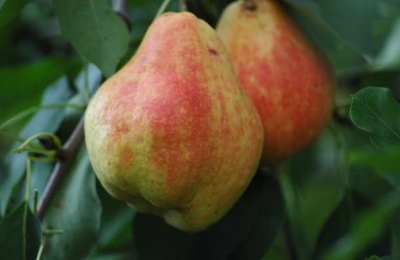
- Authors: S.T. Chizhov, S.P. Potapov, N.V. Agafonov and A.V. Isachkin, selection of the Moscow Agricultural Academy. K. A. Timiryazeva
- Fruit weight, g: 130 - 150
- Ripening terms: early autumn
- Fruit picking time: early September (before the 10th)
- Appointment: universal
- Growth type: medium height
- Yield: medium
- Marketability: high
- Crown: wide pyramidal, compact, dense
- Fruiting type: mixed, tying on all types of fruit woods
The Akademicheskaya pear variety can be a pleasant filling for any garden in many cases. But to get a good result from him, you have to try. And to begin with, to study as much as possible objective information about the culture.
Breeding history
The breeding work was carried out at the Timiryazev Moscow Agricultural Academy. It is for this reason that the culture received its non-standard name. The state test has been going on since 1997 and has not yet been completed. The project was directly supervised by such specialists as:
S. T. Chizhov;
A. V. Isachkin;
S. P. Potapov;
N.V. Agafonov.
Description of the variety
The academic pear has a versatile horticultural use. It forms medium-sized trees. The crown is more like a pyramid with a wide base in shape. This crown is characterized by both compactness and density. Fruiting is of a mixed type; shedding is not very pronounced, resistance to scab is high and the best conditions for this culture are created in the center of the European part of Russia.
Fruit characteristics
The usual fruit weight of this variety is 130-150 g. Other features are as follows:
wide pear-shaped configuration;
bumpy surface;
medium or even large size;
general yellow color;
coverage of the covering color of the entire surface of the pear (this is a dark burgundy blush);
moderately long but thickened peduncle;
guaranteed keeping quality of the crop up to 14-20 days.
Taste qualities
The white pulp of the Academic pear has a semi-oily consistency. In structure, it is very dense, which does not interfere with providing high juiciness. In general, the taste is described as a wine-sweet sensation. A faint aroma is also worth noting.
Ripening and fruiting
This variety is referred to as early autumn pears. It will be possible to start harvesting in September. Fruiting usually begins no later than September 10th. But sometimes the weather and agriculture make significant adjustments to this familiar schedule. The tree will bear fruit for 3 or 4 years.

Yield
The academic pear is prone to self-fertility. However, when a pear or apple tree with a similar cycle time is grown within a radius of 15 m, productivity increases significantly. The ability to remove up to 50 kg of fruits from 1 tree is declared.
Landing
Ready-made seedlings of the Academic pear are often bought. Reproduction is also allowed:
due to vegetative parts;
by the seed method;
vaccinations.
Cutting is considered the best solution. It is necessary to cook cuttings either in mid-June - during July, or after the completion of leaf fall. It is supposed to take healthy branches with a flat surface. A very important condition for success is the presence of a green top and lignification of the lower part.It is advisable to take sections 200 mm long, containing at least 3 leaves; the cut from the bottom is carried out at an angle of 45 degrees upward towards the kidney.
The upper part should be cut off as evenly as possible. The rooting substrate is placed in a box or box. Peat is often mixed with vermiculite or sand. Combining organic fertilizers with black soil, however, also turns out to be a good choice. Cuttings should be placed in the ground with a small gap, pre-soaking in a root formation stimulator.


Growing and care
Saplings and seedlings of Akademicheskaya pear must be covered with foil and protected from direct sunlight. It is recommended to spray from spray guns 1 time every 7 days. Other work at the stage of growing seedlings:
daily airing for 2-3 hours;
foliage control;
control over the development of roots.
Transfer to open ground is carried out in the autumn months. There should be 1 hole for 1 tree. Spunbond is usually used to protect against frost, but other material of your choice can be used. When the juices begin to move, nitrogen feeding begins, which must be completed in June; it is necessary to water the trees through the holes in the mulched near-trunk radii. There are no more fundamental features of agricultural technology.
It is useful to cover adult trees Akademicheskaya when there is a threat of a harsh winter. Fruit rot is a particular risk for this variety. Insect pests are also dangerous. Conventional insecticides help fight them. With proper protection from cold weather, you can confidently grow the Academic pear in the Urals, Altai and other areas of southern Siberia.




Like any other fruit trees, the pear needs protection from various diseases and pests. When planting a pear on your site, you need to know in advance what diseases you should beware of. To successfully carry out the struggle, it is necessary first to correctly identify the cause of the problem. It is important to distinguish signs of disease from manifestations of the presence of insects, mites, caterpillars and other types of pests.





































































